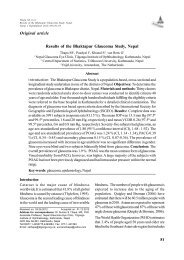nepjoph 2012.pmd - Nepalese Journal of Ophthalmology
nepjoph 2012.pmd - Nepalese Journal of Ophthalmology
nepjoph 2012.pmd - Nepalese Journal of Ophthalmology
You also want an ePaper? Increase the reach of your titles
YUMPU automatically turns print PDFs into web optimized ePapers that Google loves.
Sharma R et al<br />
Conjunctival autograft transplantation in pterygium<br />
Nepal J Ophthalmol 2012; 4(8):242-247<br />
Table 2<br />
Risk estimation for the grade <strong>of</strong> pterygium<br />
with occupation<br />
Occupation Pterygium grade<br />
Grade II Grade III<br />
Statistics<br />
Odds Ratio<br />
(95% CI)<br />
Farmers 3 7 0.019<br />
Non-farmers 23 1 (0.002 to 0.209)<br />
Presenting complaint <strong>of</strong> the patients varied largely<br />
as follows: ocular discomfort (8, 23.5%),<br />
appearance <strong>of</strong> the fleshy growth in the white portion<br />
<strong>of</strong> the eye (7, 20.6%), ocular redness (5, 14.7%),<br />
foreign body sensation (4, 11.8%) and blurring <strong>of</strong><br />
vision (1, 2.9%). However, few patients had multiple<br />
complaints (9, 26.5%) which included the cosmetic<br />
reasons. The duration since the development <strong>of</strong><br />
pterygium varied largely from 2 years (16, 47.1%)<br />
to more than 5 years (4, 11.8%) (Table 3).<br />
Table 3<br />
Duration since the first appearance <strong>of</strong><br />
pterygium<br />
Duration in years Frequency Percentage<br />
0-2years 16 47.1<br />
3-5 years 14 41.2<br />
>5 years 4 11.8<br />
Total 34 100<br />
Inflammation <strong>of</strong> the pterygium occurred twice in 14<br />
(41.2%), thrice in 5 (14.7%) and once in 4 (11.8%).<br />
The pterygium was inflamed multiple times in 11<br />
patients (32.4%). Dry eye was seen in 30 (88.23%)<br />
patients. Eighteen (52.9%) patients had a history<br />
<strong>of</strong> using topical drugs in the past for the treatment<br />
<strong>of</strong> this fleshy growth. Ten patients (29.4%) had<br />
presenting visual acuity <strong>of</strong> 6/6 on their affected eye<br />
and only nine patients (26.4%) had visual acuity<br />
below 6/18 (Table 4).<br />
Table 4<br />
The presenting visual acuity<br />
Visual acuity Frequency Percentage<br />
6/6 10 29.4<br />
6/9 8 23.5<br />
6/12 7 20.6<br />
6/18 6 17.6<br />
6/24 2 5.9<br />
6/60 1 2.9<br />
Total 34 100.0<br />
Two patients had displaced grafts, one in the third<br />
and the other in the seventh post operative follow<br />
up visit. One patient had a sutural granuloma present<br />
at the two week postoperative period which<br />
improved with suture removal and topical steroid<br />
treatment. Only three subjects (8.82%) had a<br />
recurrence <strong>of</strong> pterygium: one in two months, and<br />
the other two in six months post-operatively. No<br />
major complications were noticed in any <strong>of</strong> these<br />
patients.<br />
Discussion<br />
In spite <strong>of</strong> numerous techniques and improvements<br />
in microsurgery, recurrence <strong>of</strong> pterygium is still a<br />
major concern for ophthalmic surgeons. While the<br />
definitive management <strong>of</strong> a pterygium is surgical,<br />
the ideal adjunctive procedure is still to be<br />
determined. A wide range <strong>of</strong> recurrence rates<br />
reported has been attributed to various study<br />
differences including methodology (prospective/<br />
retrospective), patient characteristics (race, age),<br />
nature <strong>of</strong> pterygium advanced/inflamed/recurrent/<br />
progressive/atrophic), geographic area <strong>of</strong> domicile,<br />
number <strong>of</strong> patients studied, definition <strong>of</strong> recurrence,<br />
duration <strong>of</strong> follow up and loss <strong>of</strong> follow up, surgical<br />
technique and surgeon’s experience.<br />
In our study, service holders and farmers were<br />
mostly involved, which could be due to increased<br />
computer use in service holders and exposure to<br />
dust and UV rays in farmers. Exposure to dryness,<br />
hot weather and ultraviolet rays causes the primary<br />
thickening <strong>of</strong> a limbal mass, leading to limbal<br />
elevation. This in turn causes irritation and further<br />
elevation which causes exposure <strong>of</strong> the cornea due<br />
to improper apposition <strong>of</strong> the lids. Thus, a dellen<br />
forms and prevents a smooth tear film from covering<br />
the cornea. In a study done by Pandey et al (1984)<br />
males were predominant (males 1051, 75.1%;<br />
females, 349; 24.9%). It suggests that males have<br />
more exposure to external atmosphere than females,<br />
indicating that the environment plays a predominant<br />
role in pterygium formation.<br />
However, in our study there is female<br />
preponderance, which could be due to a high<br />
245




